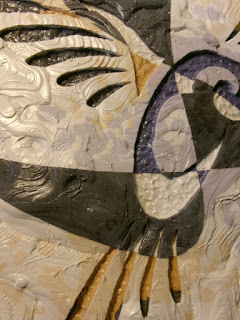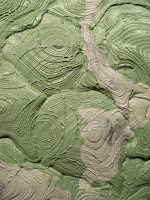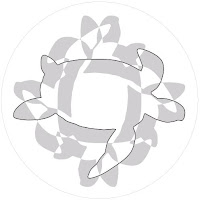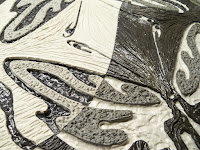By employing some relatively novel modeling & forming techniques, one can produce engaging designs with complex elements and a high degree of color separation.
- Peace (Chinese symbol)
- $350
- 18" dia
- 10 lb
- White cement. Black & blue pigments.




- Hummingbird
- $350
- 18" dia
- 10 lb
- White cement. Black, yellow, blue and red pigments.





- Nightwatch
- $350
- 15" x 21"
- 15 lb
- White cement. Black pigment.




- Untitled
- $350
- 8½×19"
- 10 lb (each)
- White cement. Red, green, blue and black pigments.




- Terra Incognito
- $250
- 12" x 21"
- 15 lb
- White and gray cement. Black iron-oxide pigment.








- Contours
- $100
- 8" x 18"
- 10 lb
- White and gray cement. Black iron-oxide pigment.




- Fluid Motion
- $100
- 12 in dia
- 7 lb
- White and gray cement. Black iron-oxide pigment.



- Grand Piano
- $100
- 12 in dia
- 7 lb
- White and gray cement. Black iron-oxide pigment.




- Kokopelli
- $100
- 12 in dia
- 7 lb
- White and gray cement. Black iron-oxide pigment.




- Sea Turtle
- $250
- 15-inch dia
- 10 lb
- White and gray cement. Black iron-oxide pigment.




- Broken In Blue
- $350
- 12 in x 21 in dia
- 15 lb
- White and gray cement. Black and blue oxide pigments.



- Drei
- $350
- 18 in dia
- 15 lb
- White and gray cement. Black and green oxide pigments.



- Nova
- $350
- 18 in dia
- 15 lb
- White and gray cement. Black and yellow iron-oxide pigment.



- Cicatrix
- $350
- 18 in dia
- 15 lb
- White and gray cement. Black and red iron-oxide pigment.



- Tanzen
- $500
- 20 in x 24 in
- 22 lb
- White and gray cement. Black iron-oxide pigment.




- Crane
- $400
- 12 in x 24 in
- 17 lb
- White and gray cement. Black iron-oxide pigment.




- Counterpoint (coffee table)
- -not for sale-
- 18 in x 30 in
- 40 lb
- White and gray cement. Black and red iron oxide pigment(s).



- Lepidoptera
- $400
- 15 in x 24 in
- 14 lb
- White and gray cement. Black iron oxide pigment.




- Meditation
- $350
- 18 in dia
- 15 lb
- White and gray cement. Black and red oxide pigments.



- Morpheus #0F0
- $375
- 18 in x 18 in
- 20 lb
- White and gray cement. Black and green oxide pigment.






- Morpheus #00F
- $375
- 18 in x 18 in
- 20 lb
- White and gray cement. Black and blue oxide pigment.




- Morpheus #F00
- $375
- 18 in dia
- 15 lb
- White and gray cement. Black and red oxide pigments.




- Morpheus #FF0
- $375
- 18 in dia
- 15 lb
- White and gray cement. Black and yellow oxide pigments.






































 (Spring 2021) The piece to the right was an exercise in a slightly 3D approach by incorporating raised shapes (ovals) interlocking with embedded shapes (rectangles).
(Spring 2021) The piece to the right was an exercise in a slightly 3D approach by incorporating raised shapes (ovals) interlocking with embedded shapes (rectangles).


 (Spring 2021) The items to the right were done mostly as a proof-of-concept exercise in which some pieces of reasonable size (they are each nominally 16-inches in width, or primary dimension) were designed with a fairly high degree of element complexity to see how well the technique would scale beyond "test-tile size" (about 6-inches). Designed to hang on a wall, each piece is nomimally 5/8-inch thick (& made of GFRC concrete).
(Spring 2021) The items to the right were done mostly as a proof-of-concept exercise in which some pieces of reasonable size (they are each nominally 16-inches in width, or primary dimension) were designed with a fairly high degree of element complexity to see how well the technique would scale beyond "test-tile size" (about 6-inches). Designed to hang on a wall, each piece is nomimally 5/8-inch thick (& made of GFRC concrete).
 (Winter 2020) The Yin & Yang design isn't complicated in terms of the design elements, but the contrast between the white and black concrete is still striking enough to really capture one's attention. The technique for realizing very tight control over concrete placement is still evolving.
(Winter 2020) The Yin & Yang design isn't complicated in terms of the design elements, but the contrast between the white and black concrete is still striking enough to really capture one's attention. The technique for realizing very tight control over concrete placement is still evolving.
At the time of this writing (Feb-2019), this work is still very experimental. There is still a lot more to do.
A few preliminary designs (18" dia, 3/4-1" nominal thickness, polymer-modified concrete with GFRC backing) are shown below:




Both in terms of fabric-forming and table-top techniques, the following pieces are among some fairly early works. The pedestals are a single cylinder of fabric (with a piece of rebar in the middle). I was still using a sand-casting approach for all fabric-formed pieces and hadn't yet graduated to anything more imaginative than simple cylinders. The table-tops (15" dia x 2" thick) are also relatively simple affairs, with different colors of concrete cast directly against a flat surface (I used formica). The "edges" were formed using wet river sand. In some cases, different colors of concrete were just "dumped" on the formica and then consolidated by "swirling" a small, homemade vibrator in circles. In other cases, small precast cylinders (i.e. the white circles) were placed in a pattern and then concrete was placed around them. Finally, different patterns and colors could also be placed in stages over several days.








